Contents:
Solar panels play a critical role in the global shift toward renewable energy, serving as a bridge between sunlight and usable electricity. The energy transformation that occurs in a solar panel is a fascinating process that embodies advanced science and technology. This article delves into the key stages of energy conversion, highlighting how solar energy is transformed into electrical energy efficiently.

The Energy Transformation Process in Solar Panels
-
Absorption of Sunlight (Solar Energy to Photon Energy):
Solar panels are composed of photovoltaic (PV) cells made from semiconductor materials, such as silicon. When sunlight hits these cells, the energy from the photons is absorbed, exciting electrons within the material.
-
Generation of Electric Current (Photon Energy to Electrical Energy):
The excited electrons move freely, creating an electric current. This movement is facilitated by an electric field within the PV cell, which directs the flow of electrons in a single direction, generating direct current (DC).
-
Conversion to Usable Electricity (DC to AC):
The generated DC electricity is then passed through an solar inverter, where it is converted into alternating current (AC). AC electricity is used by most household appliances and commercial facilities.
-
Storage or Distribution (Electricity Management):
The electrical energy can either be stored in batteries for later use or sent directly to the grid, providing power for homes, businesses, and industrial operations.
Solar Energy Transformation at a Glance
Below is a detailed table summarizing the key steps of the energy transformation process:
| Stage |
Input Energy |
Output Energy |
Description |
| 1 |
Solar Energy |
Photon Energy |
Sunlight is absorbed by photovoltaic cells. |
| 2 |
Photon Energy |
Electrical Energy (DC) |
Excited electrons generate an electric current. |
| 3 |
Electrical Energy (DC) |
Electrical Energy (AC) |
DC is converted into AC using an inverter. |
| 4 |
Electrical Energy (AC) |
Power Supply |
Electricity is used directly or stored in batteries. |
Efficiency Trends in Solar Panel Technology
Over the years, solar panel technology has witnessed remarkable improvements. Efficiency levels of early photovoltaic cells were as low as 6%, while modern cells now boast efficiencies exceeding 22% in commercially available products. Research into cutting-edge materials, including perovskites and tandem cells, promises even higher efficiency rates in the future.
Solar Energy Production Over the Week
The chart below represents the trends in solar panel efficiency over the decades, highlighting key milestones in technological advancements.
Solar energy has evolved through significant milestones that have shaped its adoption and efficiency. From early discoveries to modern innovations, these milestones highlight the continuous advancement in harnessing solar power.

Below is a detailed table summarizing the key milestones in the development of solar energy:
| Year |
Milestone |
Significance |
| 1839 |
Discovery of the Photovoltaic Effect |
Alexandre Edmond Becquerel discovers that light can generate electricity. |
| 1954 |
Invention of the Silicon Solar Cell |
Bell Labs creates the first practical solar cell with 6% efficiency. |
| 1973 |
Oil Crisis Sparks Interest |
The oil crisis leads to increased research into alternative energy sources. |
| 2000s |
Rapid Cost Reductions |
Advancements in manufacturing reduce solar panel costs significantly. |
| 2020s |
Emergence of Perovskite Solar Cells |
New materials promise higher efficiency and lower production costs. |
Economic and Environmental Benefits of Solar Energy
Solar energy is not only a cleaner alternative to fossil fuels but also a cost-effective solution for the long term. Here are some key benefits:
-
Cost Savings:
Solar installations reduce electricity bills for households and businesses by offsetting grid energy consumption.
-
Job Creation:
The solar industry creates numerous jobs in manufacturing, installation, and maintenance, contributing to local economies.
-
Carbon Footprint Reduction:
Solar power systems significantly decrease greenhouse gas emissions, mitigating climate change.
-
Energy Independence:
Nations can reduce their dependence on imported fuels by investing in solar energy, bolstering energy security.
Challenges in Solar Energy Adoption
Despite its benefits, solar energy faces several challenges that need to be addressed to achieve widespread adoption:
-
Intermittency Issues:
Solar panels rely on sunlight, making energy production weather-dependent. Energy storage solutions like batteries are essential for consistent power supply.
-
Initial Investment Costs:
Although costs have decreased, the upfront investment for solar panel installation remains a barrier for some households and businesses.
-
Land and Space Requirements:
Large-scale solar farms require significant land, potentially conflicting with agriculture and conservation efforts.
-
Recycling and Waste Management:
As solar panels reach the end of their lifespan, managing waste and recycling materials is crucial to maintaining sustainability.
Harnessing the Power of Transformation
The energy transformation in a solar panel—from sunlight to usable electricity—illustrates the remarkable potential of renewable energy technologies. By converting solar energy into electrical power through advanced photovoltaic processes, solar panels empower individuals and industries to meet their energy needs sustainably. This seamless and efficient transformation is a testament to human ingenuity and a crucial step toward a greener, more energy-secure world. As solar technology continues to evolve, its role in shaping a sustainable future will only grow, lighting the way for generations to come.
FAQs on Energy Transformation in Solar Panels







